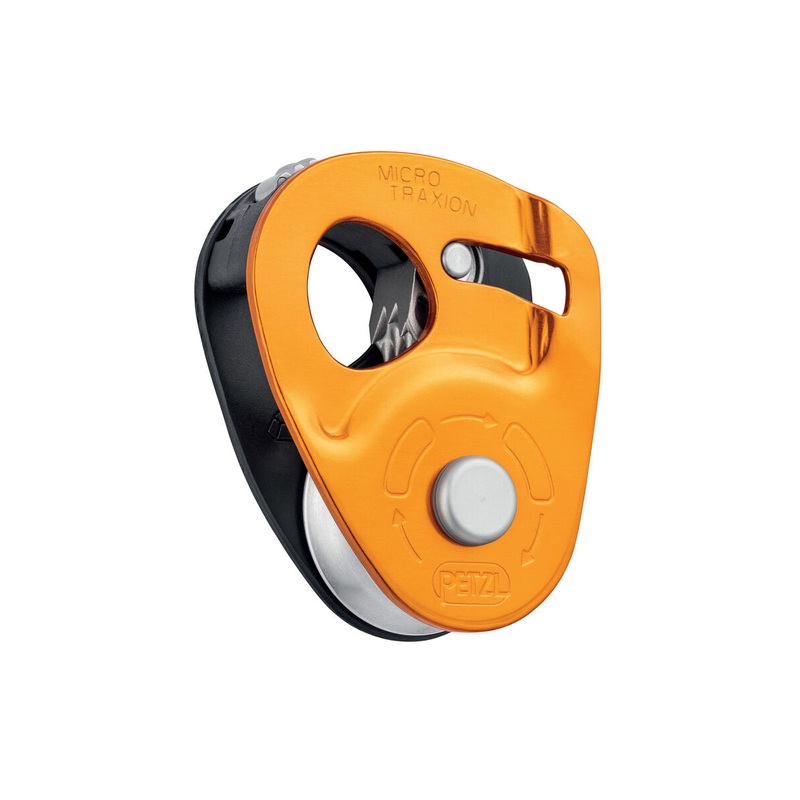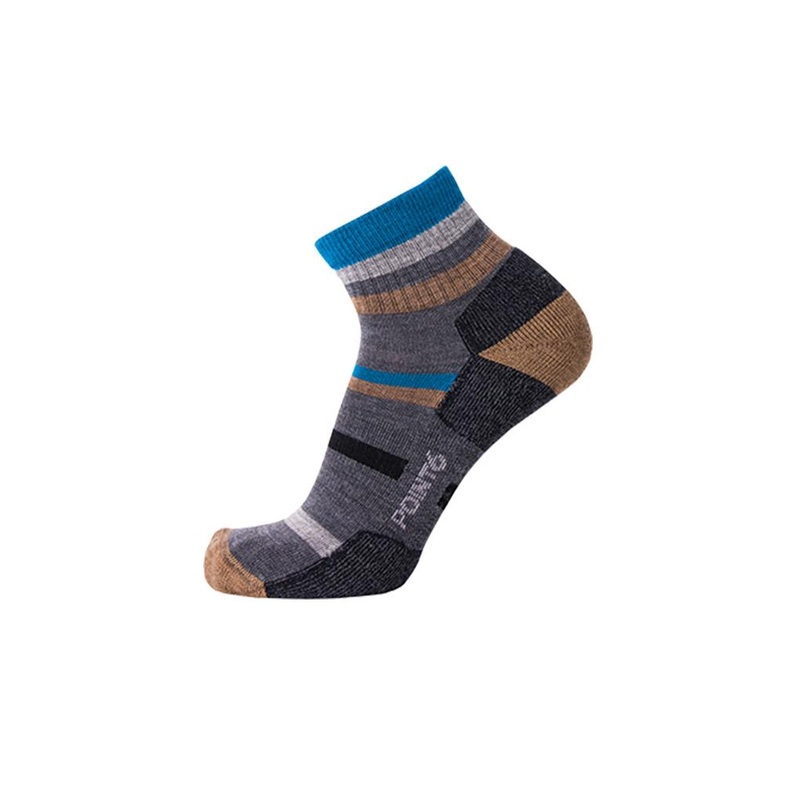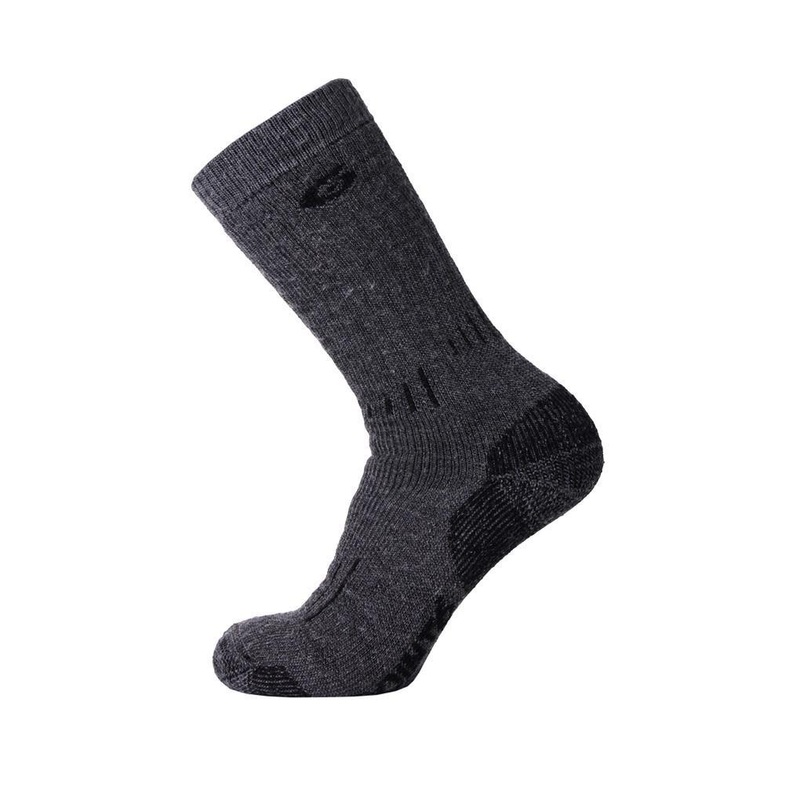Description
The Petzl Micro Traxion is a versatile and lightweight progress-capture pulley (weighing only 85 g) perfect for various applications such as crevasse rescue, hauling, self-rescue, and even emergency ascending. The locking mechanism allows the cam to remain open, transforming the device into a basic pulley. Additionally, the sealed ball bearings offer exceptional efficiency (91%).
Features
- Versatile:
- Suitable for crevasse rescue, hauling, self-rescue, and functioning as an emergency ascender.
- Can be used as a simple pulley by securing the cam in the raised position.
- Very light and compact:
- Weighs only 85 g.
- A hole enables an SmD carabiner to be attached to the pulley with a cord, preventing loss.
- High efficiency:
- Sealed ball bearings ensure exceptional efficiency (91%).
- Operates effectively even on frozen or muddy ropes.
- Compatible with ropes ranging from 7 to 11 mm in diameter.
- Rope installation diagrams are engraved inside the pulley for guidance.
- It is compatible exclusively with the PURLINE 6 mm cord for hauling a pack. Additional details can be found in the Instructions for Use at www.petzl.com.
- It is also compatible with the RAD LINE 6 mm cord. For further information, please refer to the Instructions for Use at www.petzl.com.
Specifications
| Weight | 85 g |
| Certification(s) | CE EN 567, UIAA |
| Min. rope diameter | 7 mm |
| Max. rope diameter | 11 mm |
| Sheave type | Sealed ball bearings |
| Sheave diameter | 27 mm |
| Working load | 2 x 2.5 = 5 kN |
| Breaking strength | 2 x 7.5 = 15 kN |
| Working load as progress capture pulley | 2.5 kN |
| Breaking strength as progress capture pulley | 4 kN |
| Efficiency | 91 % |
| Inner Pack Count | 1 |
Technology
Technical Notice
- Download the PDF : technical-notice-MICROTRAXION-1 – 3.03 MB
Declaration Of Conformity
- Download the PDF : UE-Declaration-P53-MICRO TRAXION – 0.72 MB
Tips for maintaining your equipment
- Download the PDF – 2.72 MB
Inspection
PPE inspection procedure
- Download the PDF – 3.80 MB
PPE checklist
- Download the PDF – 0.19 MB
Technical Content
INTRODUCTION
|
WARNINGS
|
The MICRO TRAXION is effective in rescue situations.
Its compactness and light weight allow it to always be carried with you in most vertical activities. It has many possible uses, from self-rescue to helping a partner in difficulty.
PULLEY SYSTEM EFFICIENCY TESTS WITH MAESTRO, ID S, PRO TRAXION, ROLLCLIP…
There can be a big difference between the theoretical efficiency of a pulley system and its actual efficiency. Here are test results from the Petzl lab.
1. Efficiency depending on the device used at the head of the system.
The force required to raise a 100 kg mass was tested under several configurations with different devices at the head of the system and with ropes of various diameters.
Test Protocol:
- Ropes tested: RAD LINE 6 mm, 7 mm cord, SEGMENT 8 mm, PUSH 9 mm, CLUB 10 mm, PARALLEL 10.5 mm, AXIS 11 mm, VECTOR 12.5 mm.
- Measurements were made with a constant pull rate of 1.5 meters/minute, on new devices and ropes.
- The results are given for information only; in the field there are numerous variables to take into account (position of haul system elements, rope diameter and construction, hauling speed, hauling smoothness, the haul load…).
| SIMPLE DIRECTIONAL (1:1) |
|
Note: Pulley efficiency ratings in the Instructions for Use are based on values measured with a simple 1:1 directional. Hauling efficiency F = xx M is the value obtained with the smallest compatible rope diameter for the device. The pulley efficiency expressed in % is calculated from this value. Efficiency is always less than 100%, which is the efficiency of an ideal pulley (impossible in reality). Example for MAESTRO S: F = 116 M, efficiency = 86% |
| SIMPLE DIRECTIONAL (2:1) |
| HAUL SYSTEM (3:1) |
| HAUL SYSTEM (4:1) |
| HAUL SYSTEM (5:1) |
2. 3:1 Haul system efficiency depending on the redirect point used
BELAYING THE SECOND WITH A MICRO TRAXION OR NANO TRAXION: BEWARE OF ANY FALL
MICRO TRAXION and NANO TRAXION are not belay devices. They were not designed or certified for this use. For practical reasons, however, they are sometimes used to belay a climber from the top anchor of a route. Petzl has conducted a series of tests to understand the limits and risks of this practice.
What makes it feasible to consider using a progress-capture pulley to belay a second, is that the rope above the climber can always be kept taut, thus preventing a free-fall.
For this, the belayer must be especially vigilant: they must take up rope as the climber progresses and avoid any slack between the anchor and the climber.
In particular, when nearing the anchor and during belay-station maneuvers, a 50 cm loop of slack can form very quickly, so all of the climbers movements must be carefully monitored.
WARNING: Using a progress-capture pulley to belay a second does not allow you to belay them effectively if they want to descend during the climb. It is recommended that the climber be informed of the use of this belay technique and that they know their own personal limits, so that they will also take appropriate precautions.
Certain situations can complicate the maneuver and increase risk:
- An overhang that the climber might not be able to pass: if the second is hanging on the rope, it becomes very complicated to safely lower them. The belayer should instead consider hauling to assist the climber in passing the overhang.
- A pitch that ends with a traverse: when the last quickdraw is unclipped, there is a risk of falling directly on the anchor. If the rope has been properly taken up as the climber progressed, it would mean a pendulum fall.
- Possible movements during belay-station maneuvers. WARNING: the climber absolutely must not climb to the level of the anchor and/or above the progress-capture pulley.
Tests Conducted To Better Understand The Risks Of This Use:
The fall tests were done with a flexible dummy (approximating the behavior of a human body). WARNING: these test results are provided for illustrative purposes only; many factors can worsen the results. In any case, it is recommended to avoid any falls.
Note: One total rope failure was observed during these tests, on a very worn rope (result in red). The results marked in orange represent failure of the ropes sheath and one or more core strands, which is already an especially dangerous situation for the climber.
Measurement of the critical fall distance depending on the weight of the climber.
| Fall factor 1 test, on new 9 mm VOLTA GUIDE rope. |
| Fall factor 1 comparison, on one strand of new 7.7 mm PASO half rope. |
Comparison of results if a worn rope is used
WARNING: The behavior of worn ropes is not repeatable (depending on their level of wear and the type of wear); these results are given for illustrative purposes only (the tests were done with a well-worn rope).
The essential point to remember is that for this use, a worn rope must be used with even more vigilance than a new rope. (The opposite of a lowering situation where a new rope tends to be more slippery.)
Pendulum Fall Tests
When a pitch ends with a traverse, the risk of a pendulum fall cannot be avoided.
The tests were done for a fairly realistic case of a fall on 2 m of rope when the climber is 1.8 m from the anchor, at the same level.
Tests done on new rope only.
HAULING A BAG: PREPARATION AND TECHNIQUE
In aid climbing, it is essential to organize your equipment. It is impossible to empty your haul bag at each station to find an item forgotten at the bottom. Each item must have its place. In the same way, organization for hauling should also be efficient. First of all, having several bags of 30 to 40 kg, rather than one 80 kg bag, is a good idea. It is not uncommon to see an inexperienced party leave with a huge bag and spend two or three hours hauling it up one pitch! Choosing the hauling technique best suited to, for example, a traverse or a big overhang is also key. Here are some tips for efficiency and for avoiding any serious errors. Before you head off for a vertical adventure of two or three days, practice is strongly recommended.
1. Preparing for Hauling
Attachment of Haul Bag
The haul bag should always remain attached. The attachment knot should be protected with a cut plastic bottle to keep it from snagging in a crack or under an overhang. Between the knot and the bag, you can use a SWIVEL to avoid rope twists during manipulations. Only one of the bag’s two haul straps is attached to the carabiner or quick link under the SWIVEL. This way it is easy to open the bag without dropping it. When hauling, nothing should stick out from the bag, and the sling should be folded behind the flaps. Have a lanyard ready for attaching the bag to the station (a knotted rope end is perfect).
Installing a progress capture pulley
Install a PRO TRAXION progress capture pulley on the station.
2. Hauling Technique
Balancier Technique
The easiest and most efficient hauling technique is the “balancier” on the ASCENSION handled rope clamp. It uses the weight of the body as a counterweight to raise the bag. This technique is efficient, although it can only be used with a light bag (30 to 40 kg). For heavier bags, you can either use two climbers for counterweight or employ other hauling techniques.
Warning: during these manipulations, the counterweight climber must always remain attached to the station with a rope.
Traverses and Overhangs
When the pitch is a traverse or a big overhang, the hauling technique needs to be adapted. The goal is to place the bag plumb with the direction of the hauling station to limit pendulums and stress on the anchor.
First, attach the bag several meters from the lower end of the rope. The lower climber lowers the bag on a Munter hitch while the upper climber hauls gently.
Once the bag is vertically aligned with the upper anchor, normal hauling continues.
Munter Hitch
SELF-BELAY: SOLO CLIMBING WITH ONE OR TWO FIXED ROPES
|
Important: In climbing or mountaineering, climbing with a partner or in a team offers the highest level of safety.
|
In climbing or mountaineering, climbing with a partner or in a team offers the highest level of safety.
Nevertheless, fixed-rope solo climbing is an option that un number of climbers have taken, experimenting with a variety of technical solutions.
Petzl has not developed a device for this activity, but certain ascenders may be used for it by experts.
The following characteristics are essential for any self-belay system:
- Effective and immediate blocking in all situations.
- Easy sliding along the rope while climbing.
- Redundancy of the belay.
- Comfort and ease of use.
- A continuous belay during climbing and all operations.
Among the technical decisions to be made by the climber in each situation, one is essential: the appropriate level of redundancy. This level of redundancy will impact both the complexity and the reliability of the belay system.
|
Introduction to the principle of redundancy of the belay Considering the possible failure of a single belay system (e.g. in the event of an accident, or error during installation or use), Petzl recommends the use of two systems. The |







Reviews
There are no reviews yet.